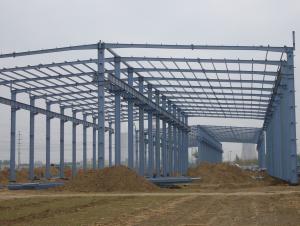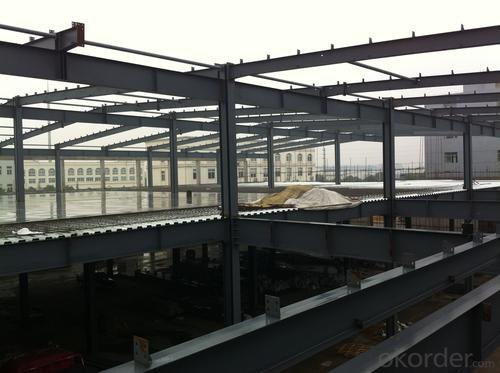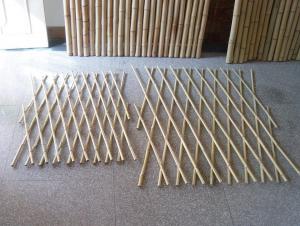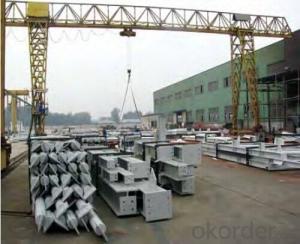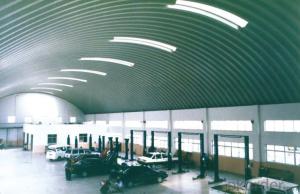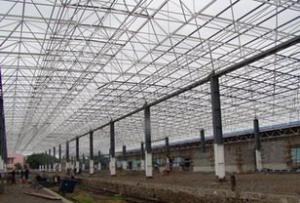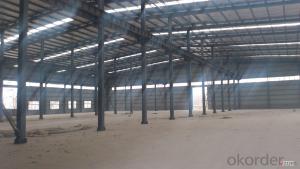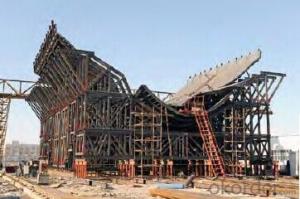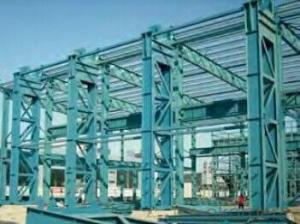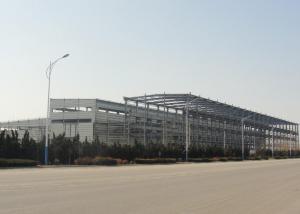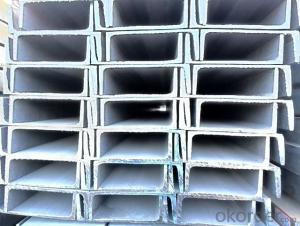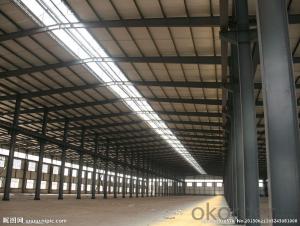Factory steel structure drawing
- Loading Port:
- China Main Port
- Payment Terms:
- TT OR LC
- Min Order Qty:
- -
- Supply Capability:
- -
OKorder Service Pledge
OKorder Financial Service
You Might Also Like
Specifications
Specifications
1) . Easy to install, fire proof, good insulation
2). Certification: ISO9001:2000, SGS Standard.
Steel Structure Warehouse:
1.The steel structure of the connection method: welding connection
2.Steel structure design common norms are as follows: "Steel Design Code" (GB50017-2003) Cold-formed steel structure technical specifications" (GB50018-2002) "Construction Quality Acceptance of Steel" (GB50205-2001) "Technical Specification for welded steel structure" (JGJ81-2002, J218-2002) "Technical Specification for Steel Structures of Tall Buildings" (JGJ99-98)
3.The characteristics of steel Light weight steel structure Higher reliability of steel work Steel anti-vibration (earthquake), impact and good Steel structure for a higher degree of industrialization Steel can be assembled quickly and accurately Large steel interior space Likely to cause sealing structure Steel corrosive Poor fire-resistant steel Recyclable steel shorter duration
4.Commonly used steel grades and performance of steel Carbon
structural steel: Q195, Q215, Q235, Q255, Q275, etc.
High-strength low-alloy structural steel Quality carbon structural steel and alloy structural steel Special purpose steel Product Feature Carport, House, Office, Shop, Toilet, Villa, Warehouse, Workshop, Plant Other Information
Products have been all over the country more than 20 provinces, municipalities and autonomous regions, and have been exported to Europe, North America, the Middle East, Africa, Asia and other countries and regions, the widespread use
Welcome to our factory, we assure that our products will satisfy your needs with designs, competitive performance price ratio and best services.
- Q: What are the different types of steel coatings for protection against corrosion?
- There are several different types of steel coatings available for protection against corrosion. These coatings are designed to create a barrier between the steel and its surrounding environment, preventing moisture and corrosive substances from coming into contact with the metal surface. One common type of steel coating is galvanized coating. This involves applying a layer of zinc to the steel surface through a process called hot-dip galvanizing. The zinc forms a protective barrier that prevents corrosion by sacrificing itself to protect the underlying steel. Galvanized coatings are widely used in outdoor applications such as fences, roofs, and structural components. Another type of steel coating is the epoxy coating. This coating is made from a mixture of resins and hardeners that chemically react to form a tough and durable film. Epoxy coatings provide excellent resistance against corrosion, chemicals, and abrasion. They are often used in industrial settings, such as pipelines, tanks, and machinery. Organic coatings, such as polyurethane or polyester coatings, are also commonly used for steel protection. These coatings provide a decorative finish while offering resistance against corrosion. They can be applied in various thicknesses to meet specific requirements and are often used in architectural applications, such as buildings, bridges, and automotive components. In addition to these coatings, there are also barrier coatings, such as stainless steel or aluminum coatings, which provide a physical barrier against corrosion. These coatings are often used in harsh environments where corrosion resistance is crucial, such as marine or offshore structures. Overall, the choice of steel coating depends on the specific application, environmental conditions, and the level of corrosion protection required. Each type of coating has its advantages and limitations, and it is important to consider factors such as cost, durability, and maintenance when selecting the appropriate coating for steel protection against corrosion.
- Q: How are steel structures used in the construction of automotive factories?
- Steel structures are commonly used in the construction of automotive factories due to their strength, durability, and versatility. They provide a sturdy framework for the assembly lines, storage areas, and other facilities within the factory. Steel beams and columns provide structural support, while steel roofing and cladding offer protection from the elements. Additionally, steel structures can be easily customized and modified to accommodate the specific needs and layout of an automotive factory.
- Q: How is steel used in stadiums and sports arenas?
- Steel is used in stadiums and sports arenas for various purposes, such as constructing the framework and support structures, creating grandstands and seating areas, building roof systems, and reinforcing the overall infrastructure. The strength, durability, and versatility of steel make it an ideal material for constructing large-scale sporting venues that can withstand heavy loads, provide ample seating capacity, and ensure the safety of spectators.
- Q: What is the purpose of steel columns in structures?
- The purpose of steel columns in structures is to provide vertical support and stability, distributing the weight of the structure evenly and efficiently. They help to transfer loads from the upper levels to the foundation, ensuring the overall structural integrity and safety of the building. Steel columns are strong, durable, and can withstand heavy loads, making them a popular choice in construction.
- Q: How do steel structures provide resistance against blast and impact loads?
- Steel structures provide resistance against blast and impact loads primarily due to their inherent strength and ductility. The unique properties of steel, such as high tensile strength and elasticity, make it an ideal material for withstanding extreme forces. When a blast or impact occurs, the steel structure absorbs the energy generated by the explosion or collision. This energy absorption capability is crucial in preventing the structure from collapsing or suffering catastrophic damage. Steel is able to distribute the load over a larger area, which reduces the intensity of the impact on any single point. This property is especially important when dealing with high-pressure waves or shockwaves caused by explosions. Moreover, steel is highly resistant to shattering or fragmentation. This means that even when subjected to intense forces, steel structures tend to deform rather than break into smaller pieces. This deformation ability helps in dissipating the energy and reducing the impact on the structure. In addition, steel structures can be designed to have flexibility and redundancy. By incorporating features like bracing, damping systems, or energy-absorbing materials, the structure can further enhance its resistance to blast and impact loads. These design considerations allow the structure to withstand the sudden and dynamic forces generated by blasts or impacts without compromising its overall integrity. Furthermore, steel structures can be constructed with blast-resistant materials, such as reinforced concrete or steel plates, which provide additional protection against blasts and impacts. These materials can be strategically placed in vulnerable areas to create a protective barrier that absorbs and redirects the forces. Overall, the combination of steel's high strength, ductility, energy absorption capacity, and flexibility in design make it an excellent choice for providing resistance against blast and impact loads. The ability of steel structures to withstand extreme forces ensures the safety and stability of buildings, bridges, and other infrastructure in the face of unexpected events.
- Q: What are the different types of steel members used in building structures?
- There are several different types of steel members that are commonly used in building structures. These include: 1. Beams: Beams are horizontal structural members that are used to carry loads and support the weight of the structure above. They are typically used to span large distances and distribute the load evenly. 2. Columns: Columns are vertical structural members that provide support and stability to the structure. They are designed to carry the load from the beams and transfer it to the foundation. 3. Trusses: Trusses are a framework of beams, usually in a triangular shape, that are used to support the roof or the floor of a building. They are lightweight yet strong, making them ideal for spanning large distances. 4. Plates: Steel plates are flat, thin sheets of steel that are used to provide additional strength and support to various parts of the structure. They can be used as base plates, gusset plates, or shear plates, depending on the specific application. 5. Lintels: Lintels are horizontal structural members that are used to support the load above an opening, such as a door or a window. They are typically made of steel beams or angles and help distribute the load evenly to the surrounding walls. 6. Bracing: Bracing members are used to provide stability and prevent the structure from collapsing under lateral loads, such as wind or earthquakes. They can be in the form of diagonal steel members or X-shaped braces, depending on the specific design requirements. 7. Purlins: Purlins are horizontal structural members that are used to support the roof covering and transfer the load to the main beams. They are typically used in metal building systems and provide additional strength and stability to the roof structure. Overall, these different types of steel members play a crucial role in the construction of building structures, providing strength, stability, and support to ensure the safety and durability of the overall structure.
- Q: Can steel structures be designed to be acoustically insulated?
- Yes, steel structures can be designed to be acoustically insulated. While steel is known for its strength and durability, it does have the potential to transmit sound due to its high density and stiffness. However, there are several methods and techniques that can be employed to minimize sound transmission and create acoustically insulated steel structures. One common approach is to use a combination of insulating materials and techniques to create a barrier that blocks or absorbs sound waves. This can include the use of soundproofing materials such as acoustic panels, foams, or insulation, which can be applied to the interior or exterior of the steel structure. These materials can help to absorb sound energy and minimize its transmission through the steel. Additionally, the design of the steel structure itself can be modified to minimize sound transmission. For example, the use of double walls or partitions can create air gaps that act as sound barriers. Similarly, the inclusion of resilient mounts or isolators can help to decouple the steel structure from surrounding elements, reducing the transfer of vibrations and sound waves. Furthermore, the selection of appropriate construction techniques and details can also contribute to acoustic insulation. For instance, ensuring tight joints and seals, using mass-loaded vinyl or other sound-damping materials, and employing proper insulation can all help to reduce sound transmission. It is worth noting that achieving complete sound insulation in steel structures may be challenging, especially in cases where high levels of soundproofing are required. However, with careful design, selection of materials, and appropriate construction techniques, steel structures can be effectively designed to provide a significant level of acoustic insulation.
- Q: What is the difference between a reinforced concrete structure and a steel concrete structure?
- Reinforced concrete structure is: reinforced concrete casting structure; steel concrete structure is: part of the steel structure, plus concrete structure to do, is not the same. For example, reinforced concrete structure houses you, is assembling reinforcement concrete pouring engineering; and you build a building foundation is reinforced concrete, but it is part of the steel structure (that is to say the above are just some of the steel structure of the structure).
- Q: How are steel structures used in bridges and infrastructure projects?
- Steel structures are widely used in bridges and infrastructure projects due to their strength, durability, and cost-effectiveness. They provide the necessary support and load-bearing capacity required for large spans and heavy traffic. Steel bridges can be easily fabricated off-site and then assembled on-site, reducing construction time. Additionally, steel allows for flexibility in design, enabling engineers to create innovative and aesthetically pleasing structures. Overall, steel structures play a crucial role in ensuring the safety and functionality of bridges and infrastructure projects.
- Q: How are steel structures used in the construction of wastewater treatment plants?
- Steel structures are commonly used in the construction of wastewater treatment plants due to their strength, durability, and resistance to corrosion. They provide the necessary support for various equipment and facilities, such as sedimentation tanks, clarifiers, aeration systems, and piping networks. Steel structures can be customized and prefabricated off-site, allowing for efficient construction and easy integration with other components. Additionally, steel's recyclability makes it an environmentally sustainable choice for wastewater treatment plant construction.
Send your message to us
Factory steel structure drawing
- Loading Port:
- China Main Port
- Payment Terms:
- TT OR LC
- Min Order Qty:
- -
- Supply Capability:
- -
OKorder Service Pledge
OKorder Financial Service
Similar products
Hot products
Hot Searches
Related keywords


